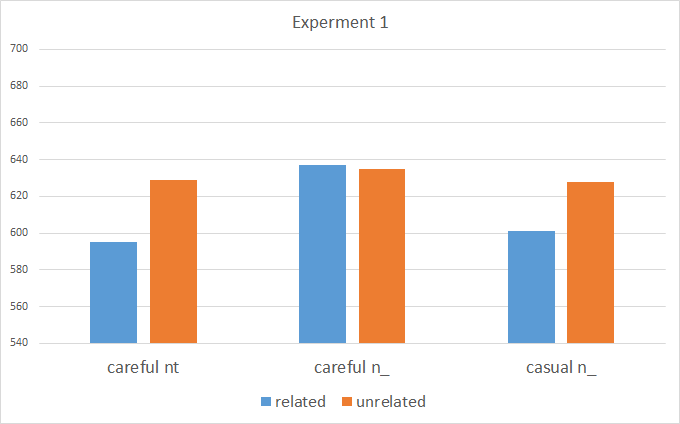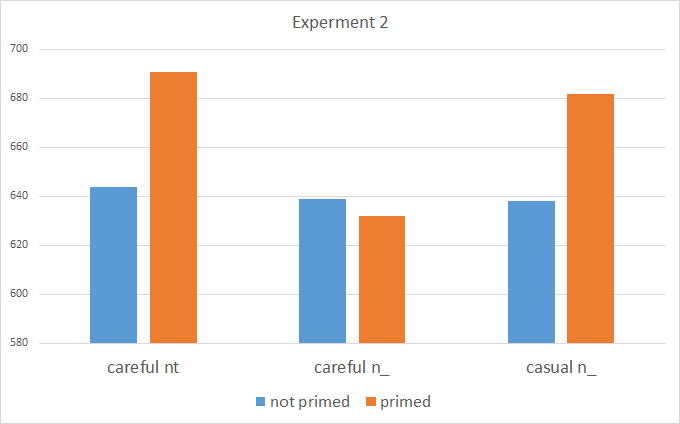A phonetic explanation of pronunciation variant effects
Meghan Sumner
JASA Express Letters (2013)
Sheng-Fu @2015/04/23
Introduction
Canonical bias vs. variant equivalence
- Carefully-articulated words in canonical forms fare better in word recognition (e.g., Pitt, 2009; Tucker and Warner, 2011)
- Multiple pronunciations of a word with different variants (e.g., [nt] vs [n_] for "center") fare equally well (e.g., Sumner and Samuel, 2005)
- no difference in canonical vs. non-canonical forms
Canonical bias vs. variant equivalence (cont.)
- Explaining the canonical bias
- prominence of the (infrequent, but) idealized word form
- [variant equivalence] depends on the [following] phonological context
- the context for variants has to be present
- [wɪkɪb] (variant for "wicked") only triggers lexical access preceding a labial-initial word (Gaskell and Marslen-Wilson, 1996)
- a word like "tas" can trigger "tast" when the following word provides a context for t-deletion (Mitterer and McQueen, 2009)
- Explaining the variant equivalence
- the co-present phonetic and/or allophonic properties in natural speech
Reconciling the two opposing views
-
Cannot be simply explained by frequency effect
-
Possibility: Variants may be linked with how a word is pronounced (phonetic composition/context)
- E.g., post-nasal [t] deletion is less likely when the following syllable is more prominent
- Hypothesis: in careful speech, the reduced form has disadvantage
Experiment 1
Semantic priming across pronunciation variants and speech styles
- Auditory Primes: English medial-nt words (e.g., splinter) produced with either [nt] or [n_]
-
all words were pronounced in three conditions:
-
careful [nt], careful [n], casual [n]
-
-
- Visual Targets: semantically related items
Participants and Stimuli
-
Participants: 60 undergraduates, monolinguals of AE
-
Stimuli:
-
48 critical primes with medial /nt/
-
144 filler primes and targets
-
48 real-real pairs, 96 pseudo-real pairs
-
-
all words were pronounced in three conditions:
-
careful [nt], careful [n], casual [n]
-
-
Design and Procedure
-
Within-subject, blocked by condition
-
One trial:
-
auditory prime -> 100 ISI -> visual target -> response
-
next trial: 1000 ms after a response, or 3000 ms
-
-
Lexical decision on the target
Hypotheses and Predictions
-
If canonical bias is independent of phonetic context
-
careful [nt] > careful [n_] and casual [n_]
-
-
If word-level phonetic context drives the difference
-
careful [nt] and casual [n_] > careful [n_]
-
Results
- Significant relatedness x prime condition interaction
- careful [n_] condition has worse priming effect (slower than careful [nt] and casual [n_] condition when words are related)

Discussion
- Replicating the results of previous findings:
- Priming effects are strong for carefully articulated canonical variants
- No priming effect for carefully articulated non-canonical variants
- New finding:
- Casual non-canonical form is just as robust in priming condition
Experiment 2
Long-term repetition priming of pseudowords
- Two goals:
- Whether the careful [n_] is a better acoustic match to a pseudoword like senner (since it's not a match to real word like center)
- Whether careful [n_] and casual [n_] result in equally robust lexical activation over the long term.
- Why pseudoword repetition?
- hearing a word inhibits the ability to reject a similar pseudoword (Sumner and Samuel, 2007)
Participants and Stimuli
-
Participants: 48 native AE speakers
-
three groups (between-subject design)
-
- Critical primes remain the same as in exp1
-
careful [nt], careful [n_], casual [n_]
-
target: [nn] pseudowords (e.g., splinner)
-
Design (quite complex...)
- Each condition has two lists
- Each list has two blocks:
- Block 1 (auditory primes and fillers):
- 24 primes (careful splinter or casual/careful splinner )
- 24 pseudoword fillers
- 36 real word filler
- Block 2 (visual targets and fillers):
- 48 targets
- 24 targets: "splinner"
- 24 "new"
- 48 pseudo word fillers (half old, half new)
- 72 real word fillers (half old, half new)
- 48 targets
- Block 1 (auditory primes and fillers):
Task/Procedure
- Task:
- block 1 (primes): pressed a button at item completion
- block 2 (targets): lexical decision
- Analysis depends on Block 2
- To see "Whether the prime inhibits the ability to reject the target pseudowords"
- Why not direct priming?
- There may be effects of form-based, not lexical, activation with direct lexical decision on the p
- Analysis on block 2 avoided explicit decisions about word form
Results
- Significant prime condition x target type interaction
- careful [n_] primes shows no inhibition effect (not slower) for primed targets

Discussion (cont.)
- The bias toward canonical variants is not due to an idealized lexical representation.
- careful [nt] = casual [n_]
- A reduced, surface-based variant is not costly to spoken word recognition.
- careful [nt] = casual [n_]
Discussion
- The recognition of variant words depends heavily on the phonetic composition of the entire word.
- careful [n_] vs. casual [n_]
- Variants experienced with different frequencies result in similar patterns
- careful [nt] = casual [n_]
- Carefully reduced variants do not get into long-term memory even when it resembles the target
Discussion and Conclusion
Explaining canonical bias vs. variant equivalence
- Differences between processing careful and casual speech
- Careful speech, processed better with clear signal
- The difference between careful [nt] vs careful [n_]
- No enough phonetic residual to cue absent sounds
- i.e., the context for reduced variants is not there
- Casual speech, noisy signal, top-town processing
- Careful [nt] worked as well as casual [n_]
- This account avoids the problem of frequency-based explanation
- Careful speech, processed better with clear signal
Conclusion
- Multiple pronunciation variants are recognized equally well in a congruent phonetic word frame.
- Canonical bias may partially be bolstered by "comparisons", not by an idealized representation.
- using a process-base account to explain the long-term memory benefits for perceived standard forms.
-
Thoughts
- No casual [nt]
- Maybe [nt] will always win regardless of the phonetic context
- Express letters
- difficult to read
- who's the audience?
A phonetic explanation of pronunciation variant effects
By sftwang0416
A phonetic explanation of pronunciation variant effects
- 583


